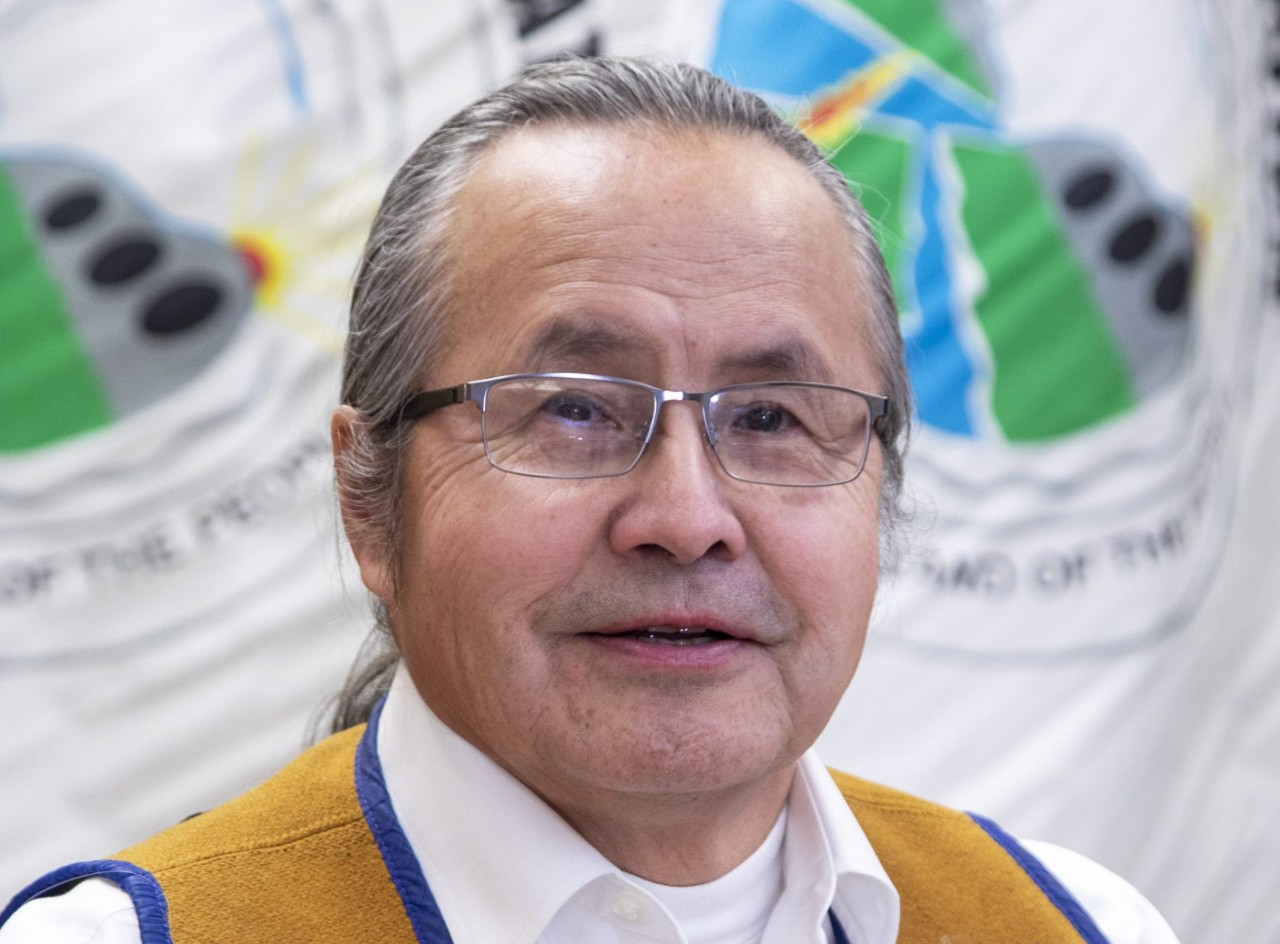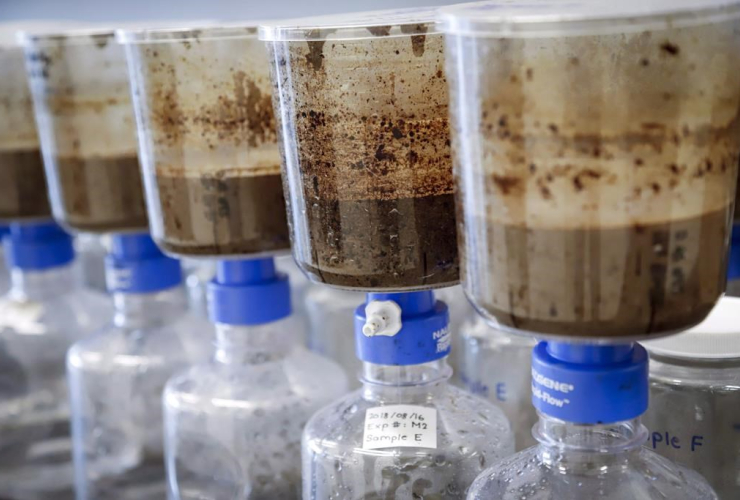The recent revelation of a massive leak from Imperial Oil’s tailings ponds highlights the question of what to do with the rest of the oilsands waste accumulating along the Athabasca River.
Massive ponds filled with more than 1.4 trillion litres of toxic waste are set to hit capacity in 2025. At that point, the sludge-like oilsands tailings will be treated and dumped into the river, in accordance with federal regulations still being developed. That is, unless Environment and Climate Change Canada (ECCC) identifies an alternative; the federal agency says dumping treated tailings is just “one of the options” under consideration.
The federal Fisheries Act currently prohibits the release of harmful substances into fish-bearing waters. The federal government is in the process of developing oilsands mining wastewater regulations under the Fisheries Act to authorize releases of treated tailings “under strict effluent quality standards to minimize risks to the environment.” Releasing untreated tailings into the Athabasca is not being considered.
But many First Nations say treated or not, oilsands tailings should not be dumped into waterways they rely on. The Athabasca Chipewyan First Nation (ACFN) is against the release of any treated tailings, and last summer at the Dene National Assembly, northern nations unanimously passed a motion opposing the government’s proposed plan.
“It has to stop,” Dene National Chief Gerald Antoine told Canada’s National Observer in an interview. “You see how they're toying around to change the rules of engagement to meet their needs or meet their wants, which doesn't meet the needs of the land or the people that live there.”
The tailings ponds are located in northern Alberta, but disposal of the thick mixture containing arsenic, leftover bitumen, toxic naphthenic acids, silt and clay will have ramifications that cross provincial and territorial boundaries. Already, evidence shows tailings are leaching into groundwater.
Fed by the Columbia Glacier in Alberta’s Jasper National Park, the Athabasca River flows north into an immense network of rivers and waterways called the Deh Cho watershed, or Mackenzie River Basin, which encompasses the northern half of Alberta, parts of British Columbia, Saskatchewan and Yukon, and most of the Northwest Territories.
The water’s 4,000-kilometre journey through the watershed ends at the Beaufort Sea.
But high levels of naphthenic acids and salinity will persist even after the toxic wastewater is treated, and releasing tar sands tailings into the watershed poses “serious risks to the rights of Dene in Treaty #8 and Treaty #11 territory,” the Dene resolution states.
The “Dene Nation opposes the release of treated tar sands tailings into the Deh Cho watershed and requires Canada to abandon its plans to allow such action,” it reads, adding that Canada must fulfil its obligation to obtain the free and prior consent of the downstream Dene.
Federal Environment Minister Steven Guilbeault has previously said the government hasn’t ruled out other options, like possible “technical solutions to tailings ponds issues.”
Currently, a Crown-Indigenous Working Group including nine First Nations and Métis communities is “exploring alternatives” to ensure all options are considered before a decision is made on the path forward, according to a statement from ECCC.
“This assessment is still in early stages and includes a global literature review to identify potential options,” read the statement, sent to Canada’s National Observer. No specific alternatives to releasing the tailings were identified in the statement.
ACFN, the First Nation that sounded the alarm about the tailings leaks on Imperial Oil’s Kearl site, is part of the working group.
The working group meetings occur every three to six weeks, and so far, the ACFN is “very happy with the process,” according to an email from Brian Fung, ACFN’s manager of government relations.
“One major outstanding issue is how to address human health,” said Fung. The federal government says human health is outside the scope of the Fisheries Act, which is, unsurprisingly, focused on fish, he explained. But Canada is obligated to deal with issues brought up during consultation so the ACFN will keep trying to get human health impacts addressed, he added.
In December, more than 40 scientists and health-care professionals penned a letter to Guilbeault outlining concerns about the proposed oilsands tailings release. Signatories say any water released must meet the highest water quality standards and insist detailed toxicological information on the makeup of tailings be made available to the public so risks can be assessed.
The regulations being developed must guarantee “no further exposure” to harmful chemicals, which the letter says contrasts with the government’s proposed “reduction of threats” approach. It points out that ongoing leaks and evaporation from tailings ponds mean there is already an elevated level of exposure to the contaminants, which releasing treated tailings would only add to.
Identifying and filling data gaps regarding the condition and composition of oilsands tailings is on the working group’s agenda, according to ECCC.
Because most studies on the composition of tailings come from industry research, it’s hard to know the chemical composition of the ponds, which is a barrier to exploring possible solutions, said Aliénor Rougeot, program manager of climate and energy with Environmental Defence.
Along with the Crown-Indigenous working group, ECCC told Canada’s National Observer it is also consulting with other Indigenous communities, including the Dene Nation.
“There have been some small steps … there is a tendency, though, to try to steer us into their process,” Chief Antoine said.
“They need to be mindful that this is our home here and that historically, we have a very special relationship with the land, we really connect with that.”
The land has its own processes and natural laws, which human beings need to acknowledge, said Chief Antoine.
Last week at the Dene Nation Water Summit, Dene families came together to share traditional knowledge and their observations and experiences. This summit was an important step to move the conversation forward, which was part of the resolution’s directive, said Chief Antoine.
The federal government’s due diligence in exploring other options is good, but there is a lack of urgency to the approach, Rougeot said. Both the provincial and federal governments are allowing the problem to grow — with about 1.5 barrels of tailings created for each barrel of bitumen extracted — with no discussion of imposing a moratorium or limiting oilsands mining expansion until solutions are identified, she said.
If released, the high salinity of treated tailings will affect the water temperature of the Mackenzie River watershed and have devastating impacts over time, said Jesse Cardinal, executive director of Keepers of the Water, a coalition of First Nations, Métis, Inuit, environmental groups and local communities committed to protecting all living things within the Arctic Ocean Drainage Basin.
The current process puts a lot of pressure on under-resourced First Nations to come up with solutions when it should be industry, with all its resources and technology, leading the way, Cardinal told Canada’s National Observer in an interview.
“Money should not be an excuse in treating the tailings ponds … [industry] shouldn't be looking for the cheapest, quickest option” at a time when companies are raking in record profits, she said.
‘We're in a climate crisis, which includes a water crisis,” she said, pointing to First Nations already without access to clean water because of proximity to industrial projects. “We're trying to reverse that and repair that, not grow that issue.”
Natasha Bulowski and John Woodside / Local Journalism Initiative / Canada’s National Observer
Define "treated."
Define "treated."
Treated sewage sludge is dumped on massive fields of corn and soy in the midwestern US ... along with plenty of toxics ...
I've got a better idea than foisting all that poison crap on waterways, First Nations, farming villages, etc. downstream: shut off the supply of clean water that feeds the homes and pools of the executive and directors of the companies that produce it, and provide their homes with big water towers filled with the stuff. They knew at the outset that the ponds would leak, regardless of what they said.
If I were producing that stuff in my backyard, I'd lose my home and I'd be in jail.
It's time for the same law to apply to oil fields as to citizens.
The IPCC is releasing another statement today. Does anyone think the government will even blink?
Alberta's O&G industry IS and
Alberta's O&G industry IS and WILL continue to permanently damage the Artic Watershed.
1.5 barrels of toxic sludge
1.5 barrels of toxic sludge PER barrel!
Add this onto all the orphan wells through the decades AND the unpaid taxes to landowners and the climate change that they KNEW about decades ago, and conservative Alberta governments come off as not only wholly negligent but truly pathological.
Those orphan wells give me an
Those orphan wells give me an idea. So, you evaporate most of the water, leaving behind horrific toxic sludge. You ship it over to those orphan wells, which are over big underground basins that used to be full of oil but are now mostly empty. You shove the gunk DOWN the well. The OIL sat there undisturbed for hundreds of millions of years until we messed with it, hopefully the gunk would too.
Simple solution. The oilsands
Simple solution. The oilsands industry is always clamouring for more pipelines.
How about an oilsands effluent pipeline emptying just upstream of Calgary and Edmonton?
If the glop is harmless, Calgarians and Edmontonians should have no objection.
"Releasing untreated tailings into the Athabasca is not being considered."
But occurring as we speak nonetheless. Thanks to our friends at Imperial Oil et al..
"Identifying and filling data
"Identifying and filling data gaps regarding the condition and composition of oilsands tailings is on the working group’s agenda, according to ECCC.
Because most studies on the composition of tailings come from industry research, it’s hard to know the chemical composition of the ponds, which is a barrier to exploring possible solutions, said Aliénor Rougeot, program manager of climate and energy with Environmental Defence."
__________
So, in essence, after decades of existence on public land, nobody knows with a sufficient degree of exactitude what's been put in to the vast ponds. How can anyone say with certainty that a plan for the inevitable cleanup or design specific cleanup techniques can be written without references to any standards or a thorough knowledge of the composition of the goo?
Another question: Will the big players pull the Orphaned Well Method of selling out to smaller companies who don't have the ability to fund the environmental liabilities of the former highly profitable operations? It seems reasonable for the feds to quickly implement a requirement for players to immediately post a $300B bond and use their power to cancel international sales before said players abscond from Canada, taking decades of profits with them and leaving taxpayers on the hook for their mess.
Unlikely? Well, they already did it once on wells, why not try it again on ponds? And if Alberta calls a requirement for bonding an anti-Alberta move, then explain to them the financial and PR consequences of getting sued by downstream communities beyond Alberta's borders for polluting their water with deadly toxins. Ditto TMX in coastal BC.
That compact Chevy Bolt EV is looking more attractive with every story I read on this topic. There are other brands, but the Bolt has the edge in independent reviews. Getting one will sever our last tie to Alberta -- the gas tank. They have a range of over 300 km and can be trickle charged to "full" over two days with an ordinary extension cord (Level 1 of 3)? This makes the decision easier for those of us with only street parking. I would contemplate a vanity plate if ICBC would allow it: F U ALTA.








Comments